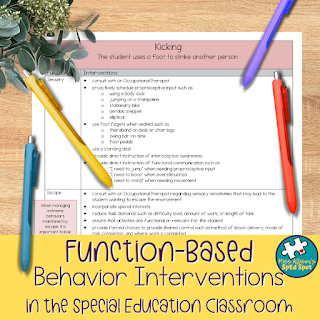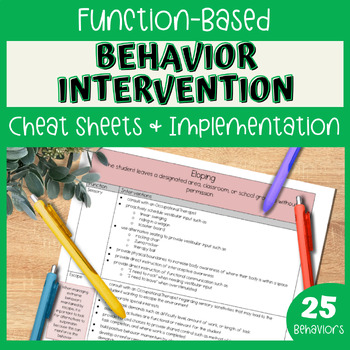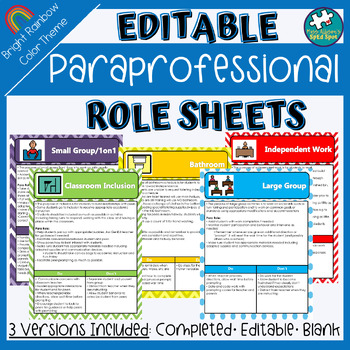In my classroom and in my role as an autism & low-incidence disability coach, few days go by when I am not trying to decipher student behavior. After working with hundreds of students and thousands of educational professionals, I have developed a 5-step system for behavioral intervention that has worked really well. In today's post, I will walk you through each step to help you with solving problem behaviors that may be impacting student success in your classroom.
Step 1: Determine the Function of the Behavior
It is essential to know what motivates a student’s behavior in order to implement function-based interventions to address the same function. If the intervention doesn’t meet the same need as the function, then it will not be effective.
There are 4 main functions of behavior.
- Sensory: Sensory-motivated behavior does not depend on others and may occur when the student is alone and without any demands being placed on them. Some examples could be humming, chair tipping, or hand flapping. Sensory-motivated behaviors are sometimes referred to as "automatically-motivated" behaviors because the reinforcement is automatic and doesn't rely on others.
- Escape: Escape-motivated behavior results in avoiding or postponing aversive or unpreferred activities. A student may elope to escape a sensory overwhelming environment or they may start throwing lesson materials in an attempt to get staff to terminate task demands.
- Attention: Attention-motivated behavior results in immediate attention from others such as a peer laughing when a student makes funny noises or a paraprofessional giving a big emotional reaction when pushed.
- Tangible: Tangibly-motivated behaviors result in access to preferred items or activities. For example, a student may climb shelving to gain access to a favorite musical toy or they may steal food from a classmate who still has some of their snack left. Tangibly-motivated behavior is sometimes referred to as "access-motivated" behavior because it allows the student access to what they want.
These scores can be determined using a behavioral assessment. I have several favorites that are all FREE! After reading about each option below, click on the links to be directed to options for each tool.
- Motivation Assessment Scale (MAS): this is a quick 16-question survey that is user-friendly and focuses on a single behavior. It is my "go-to" because it is so easy to use and can be done quickly during a team meeting or I can give it to various members of the team and average the scores to get multiple perspectives on the same behavior.
- Functional Assessment Screening Tool (FAST): this is another quick option that tends to be a favorite amongst BCBAs. It is also relatively user-friendly and focuses on a single behavior.
- Functional Behavior Assessment (FBA): this is the most comprehensive option when done well. I emphasize done well because too often I see FBAs completed just to fulfill a paperwork requirement, completed by an outside agency that truly doesn't know the student, or completed and never visited again. What a waste! A good FBA requires a team effort and lots of mindful data collection and analysis. For this reason it can be pretty time-consuming which can make it more challenging to get done.
Step 2: Choose a function-based behavioral intervention
Once the function has been determined, select an
intervention that will meet the same motivation. Interventions may change the
way staff responds to the behavior and/or may teach the individual more
appropriate ways of getting their needs met. Function-based interventions
should be implemented with fidelity across all staff members and environments. Plan
to implement this intervention for a minimum of 4 weeks.
A foundation of my Function-Based Behavior Intervention Cheat Sheets and Implementation Plan is the cheat sheets themselves which take 25 different behaviors and provides behavior intervention ideas for each of the functions of behavior for quick reference.
Step 3: Design the Behavior Plan
1. Direct Instruction: The replacement behavior needs to be explicitly taught to the student so that they understand the expectation and begin to see the benefit or how the behavior may be equally or more effective in meeting the desired function.
2. Practice: In a structured setting, set up opportunities for the student to practice the skill. Then, as appropriate, proactively schedule opportunities for the student to practice the skill in the context of their typical daily routine to promote generalization.
3. Priming: Prime the student to remind them of the replacement behavior especially before times or events that have been previously challenging. Determine consistent verbal and/or visual cues that can be used across all team members.
4. Prompting: In the moment when the student is engaging in problem behaviors and/or needs a reminder, prompt the student to use the replacement behavior. Determine consistent verbal and/or visual cues that can be used across all team members.
5. Reinforce: The replacement behavior itself should be highly reinforcing because it should meet the same function of the problem behavior. It is critical for all team members to immediately acknowledge and honor the use of the replacement behavior so that the student knows it is equally or more effective than the behavior. Additional praise or reinforcement for using the replacement behavior can also be beneficial.
Step 4: Collect Behavior Data
1. Antecedent-Behavior-Consequence (A-B-C) Checklist: Records antecedent/events (A) that immediately precede the target behavior (B), and the consequences/ events (C) that happen immediately following the behavior. I love this checklist version because it is MUCH more time-effective than anecdotal notes.
- Mastery
- The target behavior(s) have been extinguished
- The target behavior(s) have been greatly reduced to a level that is no longer significant
- Adequate Progress
- The target behavior data is steadily decreasing
- The replacement behavior data is steadily increasing
- Slow Progress
- The target behavior data is decreasing but the rate is slow
- The target behavior data has plateaued
- The replacement behavior data is increasing slowly
- Inconsistent Progress
- The target behavior data is not consistently decreasing
- The replacement behavior data is not consistently increasing
- No Progress
- The data trend has remained consistent with initial tracking for either the target behavior (remains high) or the replacement behavior (remains low)
- The target behavior data is increasing
For easy reference, more in-depth explanations, and the cheat sheets mentioned above. Head over to my TPT store to grab my Function-Based Behavior Intervention Cheat Sheets and Implementation Plan.




.png)


.png)



.png)

.png)

.png)











